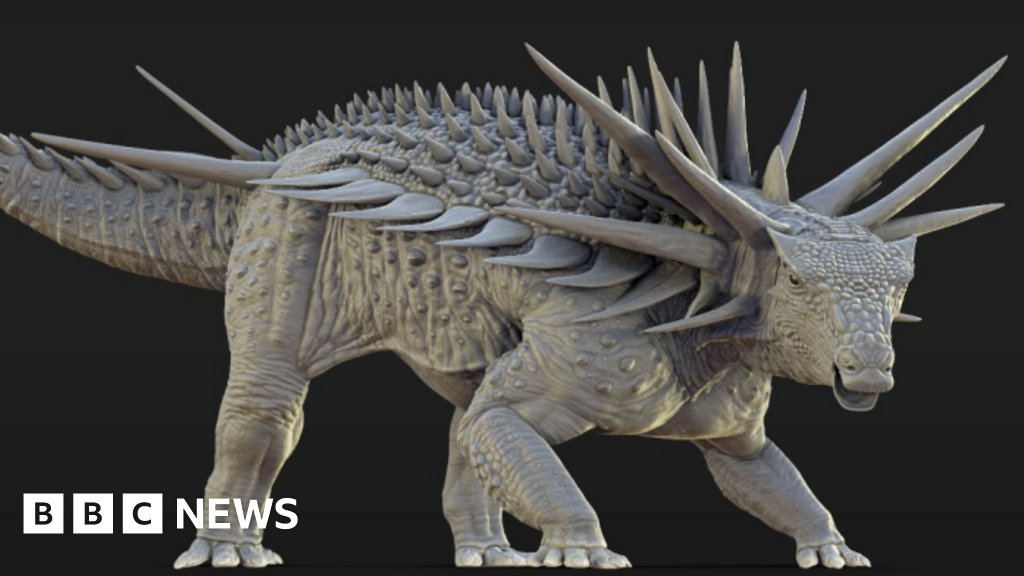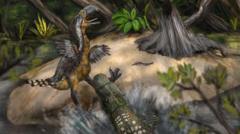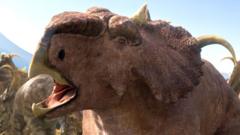Scientists have discovered a bizarre armoured dinosaur which had metre-long spikes sticking out from its neck. The species, called Spicomellus afer, lived 165 million years ago, and is the oldest example of a group of armoured dinosaurs called ankylosaurs. The elaborateness and spikiness of the animal found in Morocco has come as a shock to experts, who now have to rethink how these armoured dinosaurs evolved. Prof Richard Butler, from the University of Birmingham who co-led the research, told BBC News that it was the punk rocker of its time.
Punk rock is a sub-culture and music style that first emerged in the 1970s. Its followers often have spiky hair and accessories. It is one of the strangest dinosaurs ever discovered, said Prof Butler. Prof Butler's project co-leader, Prof Susannah Maidment of the Natural History Museum, added that it was surprising that the spikes were fused directly on to the bone. We don't see that in any other animal, living or extinct, she said. It's absolutely covered in really weird spikes and protrusions all over the back of the animal, including a bony collar that wraps around its neck and some sort of weapon on the end of its tail, so a most unusual dinosaur, she said.
The discovery is so unusual that the two professors are considering whether the discovery might force a rethink of theories on how ankylosaurs evolved. These animals survived late into the time dinosaurs were on Earth, in a period known as the Cretaceous, between 145 to 66 million years ago. At the end of this period, large predatory dinosaurs, such as T. Rex, emerged, leading experts to believe ankylosaurs started with simple armor which evolved to protect against these threats. However, the existence of Spicomellus, with its complex armor, suggests a different evolutionary path.
Prof Butler stated, Instead, we have an animal bristling with spikes like a hedgehog, the most bizarre armor that we've ever found in any animal, far outside the range of armor seen in later ankylosaurs. The researchers estimate Spicomellus was about four metres long, one metre tall, and weighed around two tonnes. The discovery was made by a local farmer in what is now the Moroccan town of Boulemane, marking it as the first ankylosaur found on the African continent. The research has been published in the journal Nature.
Punk rock is a sub-culture and music style that first emerged in the 1970s. Its followers often have spiky hair and accessories. It is one of the strangest dinosaurs ever discovered, said Prof Butler. Prof Butler's project co-leader, Prof Susannah Maidment of the Natural History Museum, added that it was surprising that the spikes were fused directly on to the bone. We don't see that in any other animal, living or extinct, she said. It's absolutely covered in really weird spikes and protrusions all over the back of the animal, including a bony collar that wraps around its neck and some sort of weapon on the end of its tail, so a most unusual dinosaur, she said.
The discovery is so unusual that the two professors are considering whether the discovery might force a rethink of theories on how ankylosaurs evolved. These animals survived late into the time dinosaurs were on Earth, in a period known as the Cretaceous, between 145 to 66 million years ago. At the end of this period, large predatory dinosaurs, such as T. Rex, emerged, leading experts to believe ankylosaurs started with simple armor which evolved to protect against these threats. However, the existence of Spicomellus, with its complex armor, suggests a different evolutionary path.
Prof Butler stated, Instead, we have an animal bristling with spikes like a hedgehog, the most bizarre armor that we've ever found in any animal, far outside the range of armor seen in later ankylosaurs. The researchers estimate Spicomellus was about four metres long, one metre tall, and weighed around two tonnes. The discovery was made by a local farmer in what is now the Moroccan town of Boulemane, marking it as the first ankylosaur found on the African continent. The research has been published in the journal Nature.


















